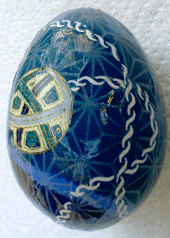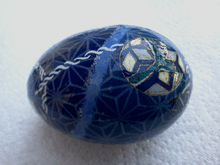Washi eggs
Washi eggs are commonly created at Easter using Japanese washi paper (as used for origami), glue, and varnish. They are made into ornaments and decorations.

Washi Egg View 1

Washi Egg View 2
Technique
A washi egg is made by first blowing the egg to remove its contents. A rectangle of washi paper, large enough to cover the egg is folded in half, and cut nearly to the midline every quarter inch (6 mm) to form a fringe of narrow strips. Each strip is trimmed to a point. The paper is unfolded, rolled around the egg, and glued on, a strip at a time; the strips overlap at the ends of the egg. The egg may then be varnished.[1]
Classes are given on US bases in Japan according to the Okinawan English language newspaper Japan Update.[2]
gollark: It *might* be possible for AutoBotRobot to issue EsoBotRobot commands.
gollark: Turns out you can run two bot programs on the same token and nothing at all stops you!
gollark: Yep!
gollark: r9k and time aren't working, though, presumably because of permissions.
gollark: <@319753218592866315> EsoBotRobot actually works!
References
- "How to make Washi eggs". How to make Washi eggs. DeviantArt. Retrieved January 1, 2012.
- Japan Update. Japanese art lends beauty to Easter holiday. 15 April 2004. Retrieved 1 January 2012.
- Robertta A. Uhl (March 15, 2007), Japanese Washi Paper Crafts. Tuttle Publishing. 978-0804838139.
- Peggy Landers Rao & Jean Mahoney (October 15, 1997), Japanese Accents in Western Interiors. Japan Publications Trading. 978-0870409882.
External links
This article is issued from Wikipedia. The text is licensed under Creative Commons - Attribution - Sharealike. Additional terms may apply for the media files.